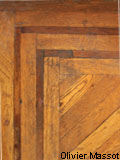- Publications:
- Newsletter:
- How-To Tutorials:
- Consumer Guides:
- Related:

Home Flooring Guide
Installation, Repair & Maintenance

“Facts On Floors: Solutions To Your
Most Annoying Problems”
By Al Ubell and Label Shulman
Published May 29, 1984 - Family Circle Magazine
Updated July 30, 2005

No doubt about it, the floors in your home suffer the worst wear and tear. These answers to your most common questions offer some inexpensive decorating and repair tricks to revitalize problem flooring.
Home Flooring Guide:
- Carpeting Basement
- Kitchen Vinyl Flooring
- Hallway Flooring
- Parquet Flooring: Installation
- Parquet Flooring: Restoration & Repair
- Finishing Wood Floors
- Painting Wood Floors
- Squeaky Floor
Carpeting Basement
Question: My basement floor has old asphalt tiles, some of which are broken or missing. How can I fix it to install carpeting?
Answer: Remove the broken tiles and replace them with any type of inexpensive tile of the same size and thickness. Secure these tiles and any other loose tiles with waterproof mastic. If only small pieces are missing, a process called “flash-patching” will work. This is a cement type of material that can be applied with a trowel; it dries in a few minutes. Then, you can install the carpeting.
Question: I want to convert my basement into a playroom for my children. Is it advisable to install carpeting in a basement?
Answer: It depends on how dry your basement is. If you have no major leakage or dampness problems, then you can install carpeting with reasonable assurance that it will hold up. Indoor-outdoor carpeting would be your best bet, since it is synthetic and manufactured with waterproof glues. If the floor is made of concrete, the carpeting should be glued down to prevent any water from getting underneath it. But, if you have a serious basement wetness problem, even this type of carpeting won't dry fast enough and will eventually develop a musty odor.
Kitchen Vinyl Flooring
Question: I want to install new vinyl tiles over the worn-out linoleum flooring in my kitchen. Do I have to remove the old linoleum or can I just install the new tile floor over it?
Answer: Before you install any new floor, all defects in the existing surface must first be repaired so that imperfections won't appear through the new flooring. If the existing floor is level and there are no cracks or blisters in the linoleum, the new tiles can be laid right on top of the linoleum with a waterproof mastic adhesive. First scrub the floor to remove any wax or surface dirt (there are commercial wax removal products that do this job well). Then, use rough sandpaper to lightly score the entire floor surface; this will provide a better sticking surface for the adhesive.
If the linoleum is in very bad shape, you will either have to remove it or cover it with a 1/8″ thick underlayment material (usually plywood or pressed board that comes in 4′ x 8′ sheets). Make sure that the underlayment is compatible with the intended use of the room. For example, a kitchen floor of ceramic or vinyl tile should have a water-resistant board as its underlayment (sometimes labeled “marine plywood” or “exterior plywood”).
Hallway Flooring
Question: My hall has wood-board flooring. Can I install vinyl tiles over it?
Answer: We don't recommend it. It's best to nail and glue down a thin 1/8″ - or 1/4″ - thick waterproof plywood or pressed-board underlayment. This will keep the seams from separating between the tiles and will prevent the floorboards from showing through. Use a waterproof mastic adhesive to secure the tiles.
Parquet Flooring: Installation
Question: We recently visited a 19th century townhouse and went simply crazy over the parquet floors. Can we install new flooring to create the same look in our home?
Answer: Absolutely. Parquet tile or decorative hardwood flooring can be installed, with relative ease, over existing floors. The patterns and types of wood are quite varied and available in most lumberyards, home centers and floor-covering showrooms. Prices, too, vary considerably, depending on the quality of the wood. If you are a bit handy, you can even do it yourself and save on installation costs. Instructions are usually easy to follow.
Parquet Flooring: Restoration & Repair
Question: Our old house has scratched and gouged wood parquet floors, with some pieces loose or missing. How can I restore these floors?
Answer: Parquet replacements can be purchased at most well-stocked lumberyards. Match the color to your existing parquet, which may be oak, birch, maple, beech or walnut. Secure the loose pieces to the floor with a polyvinyl glue. The new parquet pieces may have to be cut and shaped before gluing. For gouged and cracked areas, use a wood filling compound. Once dry, the floor can be scraped (sandpapered), stained and finished with either polyurethane, wax, boiled linseed oil, varnish or polyester resins.
Finishing Wood Floors
Question: The wood floors in my foyer and mud room get a terrible amount of wear and dampness. How can I protect the oak flooring and still retain a high-luster look?
Answer: There are several clear epoxy-type or polyester resin floor finishing products that should do the trick. They come in a two-part package. When mixed together (carefully, according to manufacturer's instructions) and applied to wood flooring, they form a thick, waterproof and tough high-gloss finish. If you prefer a satin, not shiny, finish, go over the floor lightly with some fine steel wool. This will give your floors the protection they need indefinitely.
Painting Wood Floors
Question: We want to paint the hardwood floor in our daughter's bedroom. What do we have to do and should we use a special kind of paint?
Answer: Any wood can be painted, even floors that take a lot of abuse from an active youngster. Preparation is the key. Most hardwood floors in homes are stained and/or finished with a protective coat, such as shellac, wax or polyurethane. However, paint will not stick effectively, unless you totally remove any wax from these kinds of protective coats. Commercial wax removers work well. Follow the manufacturer's instructions carefully.
Once the wax coating has been removed, it will be necessary to roughen the floor surface with a “medium/rough” sandpaper. This will allow the paint to merge with and completely cover the floor boards. The most durable type of paint for this job is a high-quality “deck” paint (check specifications on the paint-can label or ask a salesperson for help). Buy enough paint to apply two full coats to the floor. Keep the room well-ventilated while painting, and be sure to start at the farthest corner and work toward the door.
Squeaky Floor
Question: My floors squeak! What can I do to cure this?
Answer: Squeaky floors are a nuisance. You can eliminate this condition by sprinkling talcum powder directly on the floor boards in the noisy area and surrounding area. Brush the talcum powder around so it seeps into the cracks between the boards. Then sweep floor. If you're installing carpeting, leave the excess talc on the floor.

Copyright © Alvin Ubell, Label Shulman & Family Circle Magazine - 1984




